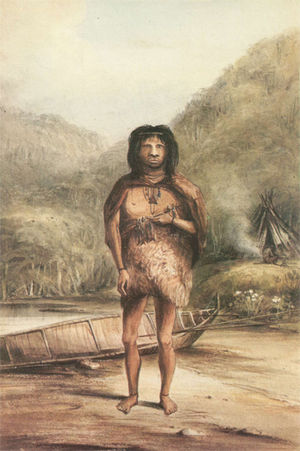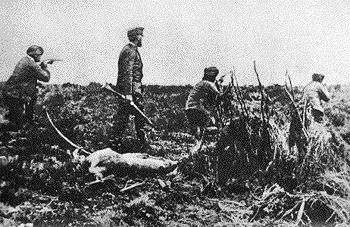- Fuegians
-
 Picture of a Fuegian (possibly a Yaghan) by ship's artist Conrad Martens during a visit of HMS Beagle.
Picture of a Fuegian (possibly a Yaghan) by ship's artist Conrad Martens during a visit of HMS Beagle.
Fuegians are the indigenous inhabitants of Tierra del Fuego, at the southern tip of South America. In English, the term originally referred to the Yaghan people of Tierra del Fuego. In Spanish, the term fueguino can refer to any person from the archipelago.
The indigenous Fuegians belonged to several tribes including the Ona (Selk'nam), Haush (Manek'enk), Yaghan (Yámana), and Alacaluf (Kawésqar). All of these tribes except the Selk'nam lived exclusively in coastal areas. The Yaghans and the Alacaluf traveled by canoes around the islands of the archipelago, while the coast dwelling Haush did not. The Selk'nam lived in the interior of Isla Grande de Tierra del Fuego and lived mainly by hunting guanacos. The Fuegian peoples spoke several distinct languages: both the Kawésqar language and the Yaghan language are considered language isolates, while the Selk'nams spoke a Chon language like the Tehuelches on the mainland.
When Europeans, Chileans and Argentines studied and settled on the islands in the mid-19th century, they brought with them diseases such as measles and smallpox for which the Fuegians had no immunity. The Fuegian population was devastated by the diseases, and their numbers were reduced from several thousand in the 19th century to hundreds in the 20th century.[1]
Contents
Material culture
Although the Fuegians were all hunter-gatherers,[2] their material culture was not homogeneous: the big island and the archipelago made two different adaptations possible. Some of the cultures were coast-dwelling, while others were land-oriented.[3][4] Neither was restricted to Tierra del Fuego:
- The coast provided fish, sea birds, seals, and sometimes also whales. Yaghans got their sustenance this way. Alacalufs (living in the Strait of Magellan and some islands), and Chonos (living further to the north, on Chilean coasts and archipelagos) were similar.[3][4]
- Selk'nams lived on the inland plain of the big island of Tierra del Fuego, hunting herds of guanaco.[3][4] The material culture had some similarities to that of the (also linguistically related) Tehuelches living outside Tierra del Fuego in the southern plains of Argentina.[3][5]
All Fuegian tribes had a nomadic lifestyle, and lacked permanent shelters. The guanaco-hunting Selk'nam made their huts out of stakes, dry sticks, and leather. They broke camp and carried their things with them, and wandered following the hunting and gathering possibilities. The coastal Yamana and Alacaluf also changed their camping places, traveling by canoes.[6]
Spiritual culture
Mythology
There are some correspondences or putative borrowings between the Yámana and Selknam mythologies.[7] The hummingbird was an animal revered by the Yámanas, and the Taiyin creation myth explaining the creation of the archipelago's water system, the culture hero "Taiyin" is portrayed in the guise of a hummingbird.[8] A Yámana myth, "The egoist fox", features a hummingbird as a helper and has some similarities to the Taiyin-myth of the Selk'nam.[9] Similar remarks apply to the myth about the big albatross: it shares identical variants for both tribes.[10] Some examples of myths having shared or similar versions in both tribes:
All three Fuegian tribes had myths about culture heros.[13] Yámanas have dualistic myths about the two yoalox-brothers (IPA: [joalox]). They act as culture heroes, and sometimes stand in an antagonistic relation to each other, introducing opposite laws. Their figures can be compared to the Selk'nam Kwanyip-brothers.[14] In general, the presence of dualistic myths in two compared cultures does not necessaily imply relatedness or diffusion.[15]
Some myths also feature shaman-like figures with similarities in the Yámana and Selk'nam tribes.[16]
Shamanism
Both Selk'nam and Yámana had persons filling in shaman-like roles. The Selk'nams believed their xon (IPA: [xon]) to have supernatural capabilities, e.g. to control weather[17][18] and to heal.[19] The figure of xon appeared in myths, too.[20] The Yámana yekamush ([jekamuʃ])[21] corresponds to the Selk'nam xon.[16]
There are myths in both Yámána and Selk'nam tribes about a shaman using his power manifested as a whale. In both examples, the shaman was "dreaming" while achieving this.[22][23] For example, the body of the Selk'nam xon lay undisturbed while it was believed that he travelled and achieved wonderful deeds (e.g. taking revenge on a whole group of peoples).[10] The Yámana yekamush made similar achievements while dreaming: he killed a whale and lead the dead body to arbitrary places, and transformed himself into a whale as well.[23] In another Selk'nam myth, the xon could use his power also for transporting whale meat. He could exercise this capability from great distances and see everything that happened during the transport.[24]
Gender
There is a belief in both the Selk'nam and Yámana tribes that women used to rule over men in ancient times,[14] Yámana attribute the present situation to a successful revolt of men. There are man festivals associated with this belief in both tribes.[25][26]
Contacts between Yámana and Selk'nam
The principal differences in language, habitat, and adaptation techniques did not promote contacts, although eastern Yámana groups had exchange contacts with the Selk'nam.[7]
Language
The languages spoken by the Fuegians are all extinct, with the exception of the Yaghan language and Kawesqar. The Selk'nam language was related to the Tehuelche language and belonged to the Chon family of languages.
Possible Australian/Melanesian origin
See also: PatagonThe Fuegians have been thought to be physically, culturally and linguistically distinct from other Native Americans. Some proponents of this theory suggest they may be the descendants of Australian Aborigines who colonized the area prior to the arrival of mongoloid Amerindians.[27] Further credibility is lent to this idea by research suggesting the existence of an ethnically distinct population elsewhere in South America.[28] Both Tehuelches and Selk'nams practiced body painting and rock art similar to that of Australian Aborigines. In contrast to most Amerindian peoples, Fuegians appeared to be taller than most Europeans (this does not include the Yaghans, who were quite short with skinny limbs and fat bodies - a physical adaptation to the cold[original research?], or the Kawesqar. Current genetic studies, however, suggest continuity between Fuegians and other Native populations.
Modern history
 Julius Popper with a killed Ona. In the late 19th century some estancieros and gold prospectors launched a campaign of extermination against the indigenous peoples of Tierra del Fuego.[29][30]
Julius Popper with a killed Ona. In the late 19th century some estancieros and gold prospectors launched a campaign of extermination against the indigenous peoples of Tierra del Fuego.[29][30]
The name "Tierra del Fuego" may refer to the fact that both Selk'nam and Yamana had their fires burn in front of their huts (or in the hut). In Magellan's time Fuegians were more numerous, and the light and smoke of their fires presented an impressive sight if seen from a ship or another island.[31] Yamanas also used fire to send messages by smoke signals, for instance if a whale drifted ashore.[32] The large amount of meat required notification of many people, so that it would not decay.[33] They might also have used smoke signals on other occasions, but it is possible that Magellan saw the smokes or lights of natural phenomena.[34]
Both Selk'nams and Yámanas were decimated by diseases brought in by colonization,[35] and probably made more vulnerable to disease by the crash of their main meat supplies (whales and seals) due to the actions of European and American fleets.
See also
- Anne Chapman
- Fuegian languages
- Indigenous Amerindian genetics
- Thomas Bridges
- Julius Popper
Notes
- ^ Die letzten Feuerland-Indianer / Ein Naturvolk stirbt aus. (Short article in German, with title “The last Fuegians / An indigenous people becomes extinct”).
- ^ Gusinde 1966:6–7
- ^ a b c d Service 1973:115
- ^ a b c Extinct Ancient Societies Tierra del Fuegians
- ^ Gusinde 1966:5
- ^ Gusinde 1966:7
- ^ a b Gusinde 1966:10
- ^ Gusinde 1966:175–176
- ^ Gusinde 1966:183
- ^ a b Gusinde 1966:179
- ^ Gusinde 1966:178
- ^ Gusinde 1966: 182
- ^ Gusinde 1966:71
- ^ a b Gusinde 1966:181
- ^ Zolotarjov 1980:56
- ^ a b Gusinde 1966:186
- ^ Gusinde 1966:175
- ^ About the Ona Indian Culture in Tierra del Fuego
- ^ Gusinde 1966:67
- ^ Gusinde 1966:15
- ^ Gusinde 1966:156
- ^ Gusinde 1966:64
- ^ a b Gusinde 1966:155
- ^ Gusinde 1966:61
- ^ Gusinde 1966:184
- ^ Service 1973:116–117
- ^ "First Americans were Australian". BBC News. 1999-08-26. http://news.bbc.co.uk/2/hi/science/nature/430944.stm. Retrieved 2010-05-03.
- ^ Neves, WA; Prous A, González-José R, Kipnis R, Powell J.. "Early Holocene human skeletal remains from Santana do Riacho, Brazil: implications for the settlement of the New World.,". J Hum Evol (2003 Jul 45(1):19-42).
- ^ Odone, C. and M.Palma, 'La muerte exhibida fotografias de Julius Popper en Tierra del Fuego', in Mason and Odone, eds, 12 miradas. Culturas de Patagonia: 12 Miradas: Ensayos sobre los pueblos patagonicos', Cited in Mason, Peter. 2001. The lives of images. P.153
- ^ Ray, Leslie. 2007. "Language of the land: the Mapuche in Argentina and Chile ". P.80
- ^ Itsz 1979:97
- ^ Gusinde 1966:137–139, 186
- ^ Itsz 1979:109
- ^ The Patagonian Canoe. Extracts from the following book. E. Lucas Bridges: Uttermost Part of the Earth. Indians of Tierra del Fuego. 1949, reprinted by Dover Publications, Inc (New York, 1988).
- ^ Itsz 1979:108,111
References
- Gusinde, Martin (1966) (in German). Nordwind—Südwind. Mythen und Märchen der Feuerlandindianer. Kassel: E. Röth. Title means: “North wind—south wind. Myths and tales of Fuegians”.
- Itsz, Rudolf (1979) (in Hungarian). Napköve. Néprajzi elbeszélések. Budapest: Móra Könyvkiadó. Translation of the original: Итс, Р.Ф. (1974) (in Russian). Камень солнца. Ленинград: Издательство «Детская Литература». Title means: “Stone of sun”; chapter means: “The land of burnt-out fires”.
- Service, Elman R. (1973). "Vadászok". In E.R. Service & M.D. Sahlins & E.R. Wolf (in Hungarian). Vadászok, törzsek, parasztok. Budapest: Kossuth Könyvkiadó. It contains the translation of the original: Service, Elman (1966). The Hunter. Prentice-Hall.
- Zolotarjov, A.M. (1980). "Társadalomszervezet és dualisztikus teremtésmítoszok Szibériában". In Hoppál, Mihály (in Hungarian). A Tejút fiai. Tanulmányok a finnugor népek hitvilágáról. Budapest: Európa Könyvkiadó. pp. 29–58. ISBN 963 07 2187 2. Chapter means: “Social structure and dualistic creation myths in Siberia”; title means: “The sons of Milky Way. Studies on the belief systems of Finno-Ugric peoples”.
Further reading
- Vairo, Carlos Pedro (1995, 2002). The Yamana Canoe: The Marine Tradition of the Aborigines of Tierra del Fuego. ISBN 9 781879 568907.
External links
- Videos
- Balmer, Yves (2003–2009). "Fuegian Videos". Ethnological videos clips. Living or recently extinct traditional tribal groups and their origins. Andaman Association. http://www.andaman-video.org/startfuegians.html.
- Audio
- Lola Kiepja. Selk'nam (Ona) Chants of Tierra del Fuego, Argentina (Streamed tracks on Napster from the audio CD)). http://music.napster.com/album/12463600.
- Excerpts from the same material on Amazon.com
- Bibliography, linking many online documents in various languages
- English
- Extinct Ancient Societies Tierra del Fuegians
- Indians page of homepage of Museo Maritiomo de Ushuaia
- German
- Dr Wilhelm Koppers: Unter Feuerland-Indianern. Strecker und Schröder, Stuttgart, 1924. (A whole book online. In German. Title means: “Among Fuegians”.)
- Die letzten Feuerland-Indianer / Ein Naturvolk stirbt aus. (Short article in German, with title “The last Fuegians / An indigenous people becomes extinct”)
- Feuerland — Geschichten vom Ende der Welt. (“Tierra del Fuego — stories from the end of the world”. Link collection with small articles. In German.)
- erdrand galleries, 9 photos
- Spanish
- Cosmología y chamanismo en Patagonia by Beatriz Carbonell. See abstract in English.
- Shaman-like figures (Selk'nam [xon], Yámana [jekamuʃ])
- About the Ona Indian Culture in Tierra del Fuego
- Rituals and beliefs of the Yámana, mentioning “yekamush”
- (Spanish) Cosmología y chamanismo en Patagonia by Beatriz Carbonell. See abstract in English.
Categories:- Indigenous peoples in Argentina
- Indigenous peoples in Chile
- Ethnic groups in Chile
- Hunter-gatherers
- Tierra del Fuego
Wikimedia Foundation. 2010.
